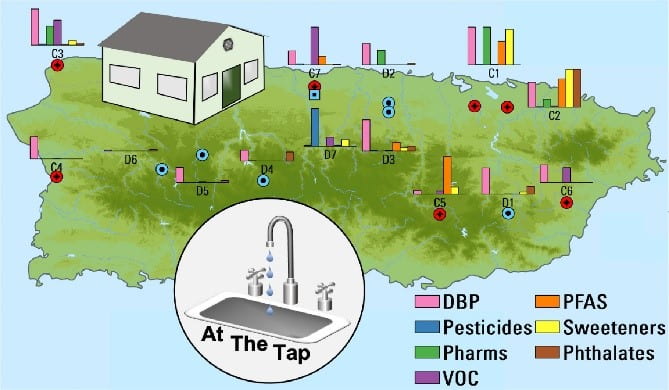PROTECT Researchers Participate in a Pilot-Scale Assessment of Puerto Rico Tap Water Contamination and Human-Health Impacts
PROTECT studies health outcomes in pregnant women in the Puerto Rico birth cohort. The home of PROTECT’s cohort is in the northern karst region of Puerto Rico, which is also the home of two of the island’s most extensive and productive drinking-water aquifers. This area has a record of groundwater contamination and drinking-water supply-well closures, and an elevated level of adverse health outcomes.
PROTECT Project 3 Leader Ingrid Padilla collaborated with researchers from the United States Geological Survey (USGS), EPA, NIEHS, and the Colorado School of Mines on a pilot-scale target assessment of mixtures of inorganic and organic contaminants in point-of-consumption drinking water (tap water, TW) in Puerto Rico.
In August 2018, the team conducted a spatial synoptic pilot assessment and collected tap water samples from seven commercial and seven home locations throughout Puerto Rico. Of the 14 samples, 10 came from Puerto Rico’s Aqueducts and Sewers Authority (PRASA) water supplies, which is the source of more than 99% of Puerto Rico’s freshwater domestic use. The tap water samples were analyzed to assess the presence of 524 organic and 37 inorganic chemicals. In December 2018, they conducted follow-up temporal assessment sampling over a three-day period in one of the commercial and one of the home locations. The recorded contaminant data were compared to common human-health standards and benchmarks.
Regulated and unregulated organic and inorganic analytes were common in the August synoptic samples. Nine of the organic and two of the inorganic contaminants detected exceeded common EPA human-health standards. Copper was detected in every sample, as were disinfection byproducts (DBP). The levels of DBPs detected were higher than observed in previous tap water studies. Lead was detected in 64% of samples. Volatile organic chemicals were found in 11 samples. Artificial sweeteners were found in more than half of the samples, suggesting that wastewater reuse is widespread throughout Puerto Rico. PFAS were detected in 50% of the samples. Most of these results are consistent with previous findings and show that people are exposed to chemical mixtures of organic and inorganic contaminants in tap water.

A graphical abstract showing in which sites different contaminants were detected.
There are a variety human-health issues that can come from exposure to these contaminant mixtures, including gastrointestinal problems, liver and kidney damage, neurocognitive impairment, and cancer. Some of the DBPs detected have no safe levels of exposure and have links to bladder cancer. Many of the mixtures or substances detected also have worse implications when exposed to more vulnerable populations, which include pregnant women and infants. This makes exposure an additional concern for adverse developmental outcomes.
Researchers express a need to further investigate the cumulative health effects of contaminant mixture exposure. There is also enough evidence from these findings to necessitate improved source-water pre-treatment technologies that reduce and remove DBP precursors. This kind of tap treatment technology may be integral in the protection of the public supply of Puerto Rico tap water.
To learn more about this study and the results, you can read the full publication here.
